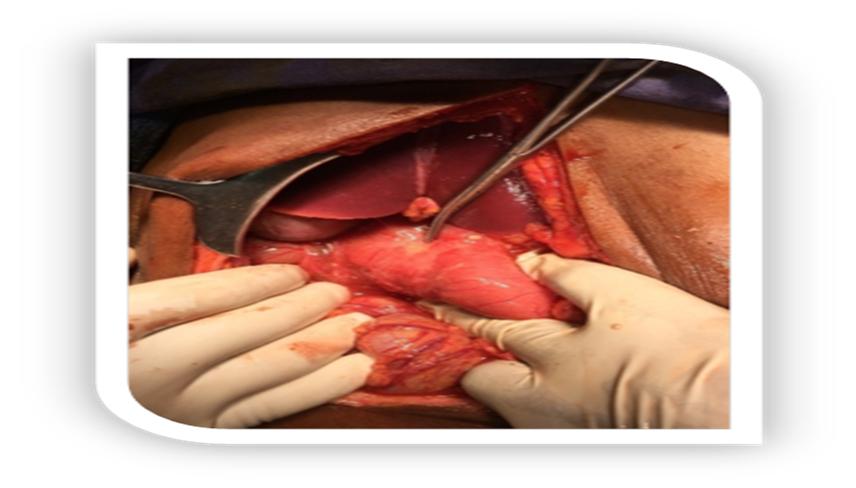
Clinical study and management of peritonitis secondary to hollow viscus perforation
Abstract
Aim:
To study the frequency of peritonitis secondary to
Hollow viscus perforation in relation to
Age.
Sex.
Symptoms.
Anatomical location.
Reliability of investigations like erect ‘X - Ray’- Abdomen.
To study the Surgical Management of Peritonitis
secondary to Hollow viscus perforation in Stanley Medical
College and Hospital.
To study complication of operative management.
Materials and Methods : The study was carried out from
January 2017 to December 2017. A thorough history and
clinical examination of the patients were carried out. Then,
various investigations such as Complete Blood Count
(CBC), X-Rays, ultrasound of the abdomen if needed were
done, in order to arrive at the diagnosis. Once diagnosed
patients were either treated accordingly.
Type of study: A prospective descriptive study.
Results : In this study, 50% patients were in the age group
of 21-40 years. Male to female ratio was found to be 5:1.
The most common symptom was abdominal pain which
was present in all the patients. 73.33% of cases had air
under the diaphragm. Among the 30 cases of gastrointestinal
perforation, perforation of duodenal ulcer 10 cases
(33.3%) was the commonest. The most common complication
recorded was wound infection 6 cases (20%) and
death in 1 case.
Full Text:
PDFReferences
Jhobta RS, AttriAk, Kaushik R, Sharma R, Jhobta A.
Spectrum of perforation peritonitis in India review of
consecutive cases. World J Emerg Surg 2006;
:26.
Yadav D, Garg PK. Spectrum of Perforation
Peritonitis in Delhi: 77 Cases Experience. Indian J
Surg. 2013 Apr;75(2):133–7.
Chakma SM, Singh RL, Parmekar MV, Singh KG,
Kapa B, Sharatchandra KH, et al. Spectrum of
Perforation Peritonitis. J ClinDiagn Res JCDR.
;7(11):2518.
B.A Taylor. “Spontaneous perforation of the
gastrointestinal tract”-in Gastrointestinal
Emergencies, 1 edition, edt by Gilmore Ian T, Robert
Shields London, W. B. Saunders company, 1992;
-379.
Inderbir S. 1991. "Alimentary system Gastrointestinal
tract" in Human embryology, 5th edition, McMillan
India press. 174-197.
Hamer Davidson H, Sherwood L Gorbach. “Infectious
diarrhea and bacterial food poisioning” in Sleisenger
and Fordtran’s Gastrointestinal and Liver Disease
pathophysiology/ diagnosis/management, 7th edition,
vol 2, W. B. Saunders Co, 2002: 1882-85, 1889-
William Schumer and Sheldono Burman. “The
perforated viscous diagnosis and treatment in
surgical emergencies”. The surgical clinic of North
America, edit by Nyhus Lloyd M, 1972; 52 (1): 231-
Sadler TW. 1994. "Digestive system" in Langman's
medical embryology, 7th edition, Williams and Wilkin
Company., 242-271.
Sorsi GA, Richard H, Turnage. 2002. ''Appendicitis in
Gastrointestinal and liver disease. Pathophysiology
and diagnosis / management 7th edition edit by
Sleisenger and Fordtran's., 2: 2089-2096.
Nitecki W. Colonoscopic injuries. Asian J Surg 1997;20:283-
12.
Afridi SP, Malik F, Ur-Rahman S, Shamim S, Samo KA.
World Journal of Emergency Surgery. World J Emerg Surg.
;3:31.
Nuhu A, Kassama Y. Experience with acute perforated
duodenal ulcer in a West African population. Niger J Med J
Natl AssocResid Dr Niger. 2008 Dec;17(4):403–6.
Bali RS, Verma S, Agarwal PN, Singh R, Talwar N. Perforation
Peritonitis and the Developing World. IntSch Res Not
[Internet].2014 [cited 2014 Aug 13];2014. Available from:
http://www.hindawi.com/journals/isrn/2014/105492/abs/
Dorairajan LN, Gupta S, Deo SVS, Chumber S, Sharma L.
Peritonitis in India – A decade’s experience. Tropical
gastroenterology.1995; 16: 33-38.
Washington BC, Villalba MR, Lauter CB.
Cefamendole-erythromycin-heparin peritoneal irrigation. An
adjunct to the peritonitis. Surgery.1983; 94: 576-81.
Nomikos IN, Katsouyanni K, Papaioannou AN. Washing with
or without chloramphenicol in the treatment of peritonitis. A
prospective clinical trial. Surgery.1986; 99: 20-25.
Shinagawa N, Muramoto M, Sakurai S, Fukui T, Hon K,
Taniguchi M, Mashita K, Mizuno A, Yura J. A bacteriological
study of perforated duodenal ulcer. Jap J surgery.1991; 21:
Gupta s, Gaushik R. Peritonitis – the Eastern experience.
World J Emerge Surg.2006; Apr26; 1:13.
Danapat MC, Mukherjee SB, Mishra PC. Howlader
Gastro-intestinal perforations. Indian J Surg. 1991;53(5):189-
Budhraja SN, Chidambaram M, Perianayagam W J.
Peritonitis (An Analysis of 117 cases). Ind J Surg
;35:456-464.
Ramachandra ML, Jagadesh B, Chandra SBC. Clinical
study and management of secondary peritonitis due to
perforated hollow viscus. Arch Med Sci. 2007;3(1):61-8.
Sharma L, Gupta S, Soin AS, Sikora S, Kapoor V.
Generalised peritonitis in India-The tropical spectrum. Jap J
Surg. 1991;21:272-7.
Refbacks
- There are currently no refbacks.

This work is licensed under a Creative Commons Attribution-NoDerivatives 4.0 International License.
An Initiative of The Tamil Nadu Dr MGR Medical University
 University Journal of Surgery and Surgical Specialities
University Journal of Surgery and Surgical Specialities